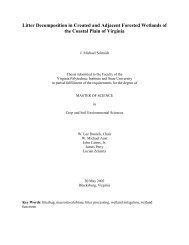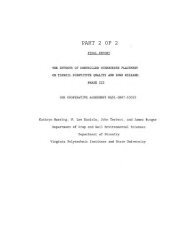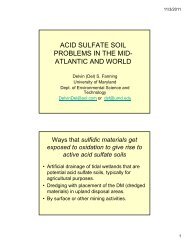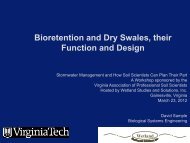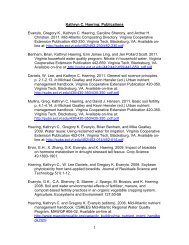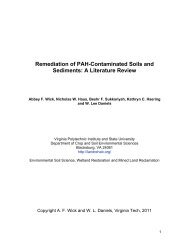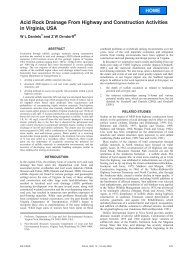ACID SULFATE SOILS - Sawgal.umd.edu - University of Maryland
ACID SULFATE SOILS - Sawgal.umd.edu - University of Maryland
ACID SULFATE SOILS - Sawgal.umd.edu - University of Maryland
Create successful ePaper yourself
Turn your PDF publications into a flip-book with our unique Google optimized e-Paper software.
SOIL DESCRIBED IN NEW UPSLOPE PIT, REFERRED TO AS PIT 1, FOR<br />
VAPSS/MAPSS <strong>ACID</strong> <strong>SULFATE</strong> <strong>SOILS</strong> TOUR ON NOV. 4, 2011. THIS PIT<br />
WAS DUG ACROSS THE BOUNDARY OF WHERE THE UPPER PART OF<br />
THE SOIL PROFILE EXPOSED IS IN THE OXIDIZED ZONE OF THE SOIL-<br />
GEOLOGIC COLUMN AND WHERE DOWNSLOPE THE OXIDIZED ZONE<br />
WAS COMPLETELY SCALPED AWAY DURING AIRPORT CONSTRUCTION,<br />
SUCH THAT THE NEW SOIL, FOLLOWING THE SCALPING IS IN THE<br />
UNOXIDIZED ZONE OF THE ORIGINAL SOIL-GEOLOGIC COLUMN.<br />
Description <strong>of</strong> soil pr<strong>of</strong>ile on scalped land surface at Stafford Co., VA, Regional<br />
Airport. This pr<strong>of</strong>ile is developed in very fine sand sulfidic Tertiary Geologic<br />
Sediments. It was described in a new backhoe pit, opened Oct. 3. 2011 by Ed Wallis,<br />
for VAPSS/MAPSS acid sulfate soils workshop tour Nov. 4, 2011. The pr<strong>of</strong>ile was<br />
described on the land surface about 2 meters upslope from the boundary between<br />
the oxidized zone and the unoxidized zone on the scalped land surface.<br />
Pr<strong>of</strong>ile:<br />
A: 0-7cm; dark reddish brown (5YR 3/3) silt loam that is essentially a root mat <strong>of</strong><br />
many fine and very fine roots <strong>of</strong> grass, hard fescue, planted in 2002 after limestabilized<br />
biosolids (sewage sludge) were added and mixed into this soil that was<br />
previously unvegetated on a scalped land surface; moderate to strong, very fine and<br />
fine granular structure; friable; pH 8.1, apparently reflecting presence <strong>of</strong> calcium<br />
carbonate, probably formed from burned-slaked lime <strong>of</strong> the biosolids; abrupt,<br />
smooth boundary.<br />
Bw: 6-31cm; strong brown (7.5YR 5/8), with common, fine, distinct 7.5YR 5/3 redox<br />
depletions, especially in the lower part; very fine sandy loam with weak, fine,<br />
subangular blocky structure with a tendency to weak medium platy primary<br />
structure in the lower part; very friable; pH 5.67; common very fine and few fine<br />
roots in upper half, but few roots <strong>of</strong> any kind below; abrupt, smooth boundary that<br />
dips into the hill upslope <strong>of</strong> the pr<strong>of</strong>ile. This horizon becomes thicker upslope and<br />
gets thinner down slope until it is absent about 2 meters down the slope where this<br />
horizon that represents the lower part <strong>of</strong> the oxidized zone <strong>of</strong> the original (predisturbance<br />
oxidized zone) soil geologic column is no longer present.<br />
Bwj: 31-54cm; brown (5YR 5/2) in upper part grading to dark grayish brown<br />
(10YR 4/2) matrix in lower part with common fine (but elongated laterally along<br />
faces <strong>of</strong> weak platy structure) prominent 5Y 7/4 jarosite and 7.5YR 5/8, probable<br />
lepidocrocite, redox concentrations; very fine sandy loam; friable; pH 4.0 in upper<br />
part and 3.9 in lower part; based on chemical tests – no violent reaction with 30%<br />
hydrogen peroxide -- see notes pertaining to this pr<strong>of</strong>ile, this horizon is judged to<br />
not be a sulfuric horizon, but to be a post-active acid sulfate soil material; abrupt,<br />
irregular boundary<br />
Cgse: 54-140+cm; very dark bluish gray (5B 3/1) very fine sandy loam or perhaps<br />
loamy very fine sand; massive; friable with tendency to be firm in situ; no roots<br />
15



